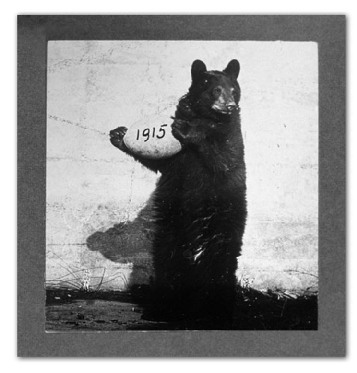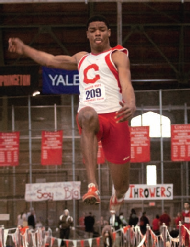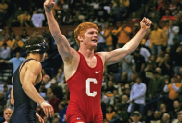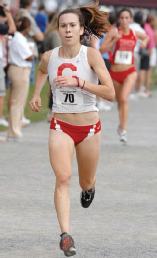In Touchdown: The Story of the Cornell Bear John Foote '74 tells tales of the Big Red's ursine mascots
In Touchdown: The Story of the Cornell Bear John Foote '74 tells tales of the Big Red's ursine mascots
 John Foote '74 has been interested in the Cornell Bear since he was a cheerleader in the fall of 1973 and shared the Schoellkopf sidelines with a fellow student dressed in a bear suit. "After reading a number of conflicting and overblown accounts of the real bears, it became clear that their history was more fiction than fact," he says, "so I thought it was time to set the record straight."
John Foote '74 has been interested in the Cornell Bear since he was a cheerleader in the fall of 1973 and shared the Schoellkopf sidelines with a fellow student dressed in a bear suit. "After reading a number of conflicting and overblown accounts of the real bears, it became clear that their history was more fiction than fact," he says, "so I thought it was time to set the record straight."
Foote, who has worked as an investment banker and the principal of a transportation engineering company, is a senior fellow at Harvard's Kennedy School and a frequent guest lecturer at Cornell. He lives in Boston and Ithaca with his wife, Kristen Rupert '74.
Touchdown: The Story of the Cornell Bear has been printed in a limited edition of 2,000 hardback copies. It's available at the Cornell Store or online at www.touchdownthebear.com and www.bookch.com. Foote has absorbed the cost of the printing, and all proceeds will go to "Far Above…The Campaign for Cornell."
Cornell began playing football in 1869, but it wasn't until 1915 that the Big Red had its first undefeated season. In fact, the 1915 season is in the record books as one of the greatest ever. Cornell was declared the number one team in the East (then the center of college football) by Walter Camp and Grantland Rice, the leading football commentators of the time.
Some of the magic of the 1915 season was conjured up by a newcomer to the Big Red football program—a black bear that was acquired by the Cornell University Athletic Association (CUAA) as a mascot. The Ithaca Journal announced the arrival of the bear in a brief notice on September 25, 1915: "For the first time in Cornell's athletic history the football team is to have a really truly live vivacious bear as a mascot. The cub was bought by Manager ["Booty"] Hunkin ['16] and Assistant Manager [Walt] Lalley ['17] at Old Town, Maine."
The Cornell Daily Sun first reported this additional member of the football team on September 30, 1915, stating that the bear was acclimating to his new environs prior to his first appearance "in an official capacity." This debut would be at the second game of the season, a home contest against Oberlin on October 2nd. The Sun also indicated that the bear had not yet been named, but that among the possibilities, "'Touchdown' will doubtless receive consideration."
Why did the Big Red football team want a bear, or any other animal for that matter, as a mascot, given that the team had experienced success without one for a number of years? The answer may lie in the fact that the CUAA depended on ticket sales for its funding and was under pressure to promote interest in football games. Numerous Sun articles from fall 1915 talk about the obligation of students to support Big Red teams by buying tickets through subscriptions to the CUAA. (The Sun asked rhetorically in an op-ed piece that appeared on October 2, 1915: "Do you know that Cornell maintains its athletic teams on less than one-third the income received by other universities such as Yale, Harvard, and Princeton?") Perhaps someone in the CUAA thought having a novelty such as a bear cub at the games would increase attendance and help narrow the gap between the Big Red and the "Big Three."
The real answer, however, is not so strategic or premeditated. As related by "Booty" Hunkin, manager of the 1915 football team, "Back in the summer of 1915, I received a letter from an animal trainer in Maine asking if we would have an interest in a black bear cub for a mascot at $25 [nearly $500 today] plus shipping charges." Booty replied in the affirmative, presumably after consulting his funders, and the cub arrived on campus in late September.
The Big Red football team beat Oberlin handily and the Cornell Alumni News reported, without elaborating, that a bear "was tethered on the field" during the game. In a letter that was reprinted in the Sun several days later, the writer asked, "Has the bear been named yet? If not, I would like to suggest 'Victory Bruin' [brewing] or 'Vic' for short."
Perhaps because he lacked a name, the bear kept a low profile over the next several weeks. According to Hunkin, the bear was lodged in the Bacon Baseball Cage (on the site of what is now Hoy Field) and was an "expensive pet and, regardless of the nursery song, this bear did not like porridge. He lived on comb honey and even at wholesale from the College of Agriculture, he required a wholesome allocation of funds."
The other reason why the bear was not the center of attention was that the brand-new Schoellkopf Field was being prepared for its dedication on Saturday, October 9, 1915, prior to the game against Williams College. (Before the construction of Schoellkopf, the team used Percy Field, the present site of Ithaca High School.) After many long dedicatory speeches that Saturday afternoon, the Big Red improved its record to 3 and 0 by making quick work of the Williams Ephs. The team continued its winning ways the following week with a lopsided victory in the "Battle of the 'nells," beating mascotless Bucknell. By this time, the bear had become a fixture at Schoellkopf.
Excerpted and condensed from the book Touchdown: The Story of the Cornell Bear by John H. Foote. © 2008. All rights reserved. Used by permission.
Sports Shorts
 STRONG SHOWING At the 2008 Indoor Heptagonal Track and Field Championships at Barton Hall, the Big Red men's team racked up a meet-record 205 points to earn its fourth indoor Heps title in six years and second straight Heps title, following its victory in the 2007 outdoor meet. Muhammad Halim '08 was named the Most Outstanding Performer for the second year in a row after defending his title in both the long jump and triple jump. A week later, Halim earned All-American honors in the triple jump with a fourth-place finish at the NCAA indoor championships, where he broke his own school record with a jump of 53 feet, 3.75 inches. Other men's Heps champions included Jordan Lester '08 in the 60 meters, Adam Seabrook '08 in the 400 meters, Zach Hine '09 in the 5,000 meters, and Joshua Kirkpatrick '10 in the pole vault. The women's team, despite winning a meet-best six events, saw its indoor Heps title streak stopped at six and its overall Heps streak end at 12, as Cornell finished third in a tight contest, just 14 points behind first-place Princeton and seven behind second-place Brown. Jeomi Maduka '09 gave Cornell a sweep of the Most Outstanding Performer awards, earning the women's honor after first-place finishes in the 60 meters, long jump, and triple jump—all with school-record performances. Other winners included Maria Matos '09 in the weight throw and Natalie Gengel '10 in the pole vault.
STRONG SHOWING At the 2008 Indoor Heptagonal Track and Field Championships at Barton Hall, the Big Red men's team racked up a meet-record 205 points to earn its fourth indoor Heps title in six years and second straight Heps title, following its victory in the 2007 outdoor meet. Muhammad Halim '08 was named the Most Outstanding Performer for the second year in a row after defending his title in both the long jump and triple jump. A week later, Halim earned All-American honors in the triple jump with a fourth-place finish at the NCAA indoor championships, where he broke his own school record with a jump of 53 feet, 3.75 inches. Other men's Heps champions included Jordan Lester '08 in the 60 meters, Adam Seabrook '08 in the 400 meters, Zach Hine '09 in the 5,000 meters, and Joshua Kirkpatrick '10 in the pole vault. The women's team, despite winning a meet-best six events, saw its indoor Heps title streak stopped at six and its overall Heps streak end at 12, as Cornell finished third in a tight contest, just 14 points behind first-place Princeton and seven behind second-place Brown. Jeomi Maduka '09 gave Cornell a sweep of the Most Outstanding Performer awards, earning the women's honor after first-place finishes in the 60 meters, long jump, and triple jump—all with school-record performances. Other winners included Maria Matos '09 in the weight throw and Natalie Gengel '10 in the pole vault.
 GRAPPLING HONORS At the NCAA Championship wrestling meet, Jordan Leen '10 won a national title at 157 pounds, capping a season that saw the Big Red earn its second straight Eastern title and sixth straight Ivy League crown. Leen entered the tournament as the eighth seed—the lowest seed to win this season. His national title is the ninth in school history. Leen was one of four Big Red wrestlers to earn All-American honors, as Cornell became the first EIWA school to have four or more All-Americans for four straight seasons. Mack Lewnes '11 was the only true freshman to reach the semi-finals and eventually finished fourth at 165 pounds. Mike Grey '11 finished sixth at 133 pounds while Steve Anceravage '09 was sixth at 174 pounds. Cornell placed ninth as a team, its fourth top-ten finish in the last six years.
GRAPPLING HONORS At the NCAA Championship wrestling meet, Jordan Leen '10 won a national title at 157 pounds, capping a season that saw the Big Red earn its second straight Eastern title and sixth straight Ivy League crown. Leen entered the tournament as the eighth seed—the lowest seed to win this season. His national title is the ninth in school history. Leen was one of four Big Red wrestlers to earn All-American honors, as Cornell became the first EIWA school to have four or more All-Americans for four straight seasons. Mack Lewnes '11 was the only true freshman to reach the semi-finals and eventually finished fourth at 165 pounds. Mike Grey '11 finished sixth at 133 pounds while Steve Anceravage '09 was sixth at 174 pounds. Cornell placed ninth as a team, its fourth top-ten finish in the last six years.
TOP FROSH The future looks bright for the Cornell hockey programs, with members of the men's and women's teams being named both the Ivy League and ECAC Rookie of the Year. Riley Nash '11 was selected as the top men's rookie after scoring 32 points on 12 goals and a team-high 20 assists. Nash, who led the team in power-play goals with seven, was also selected to the College Hockey News All-Rookie Team. For the women, Rebecca Johnston '11 was named the best first-year player after leading the team with 32 points on 16 goals and 16 assists. She is the first Cornell woman to earn either ECAC Rookie of the Year or first-team All-ECAC honors and also was named to the Canadian national team that competed at the World Championships in early April.
MAKING A SPLASH A year after finishing second, Wes Newman '09 earned his first Eastern Intercollegiate Swimming League title when he won the 200 freestyle at the league meet in March. Newman also finished third in the 500 freestyle and 200 butterfly.
OVER THE NET Seeing Cornell athletes go on to professional careers is nothing new, but Alex Dyer '07 is one of the few to do so in volleyball. Dyer, who played two years at Cornell after transferring from Seton Hall, is a member of Odbojkaski Klub OTP Banka Pula, a professional team in Pula, Croatia. The team plays in the top European professional league with a season that runs from September until May. Dyer helped the Big Red to two Ivy titles during her time on the Hill and ranks third in Cornell history with a career average of 3.0 kills per game.
 ACADEMIC HONORS Both the men's and women's cross country squads were named 2007 All-Academic teams by the National Track and Field and Cross Country Coaches Association; they qualified by scoring at the NCAA regional meet and having a combined grade-point average of 3.0 or better. Stephanie Pancoast '10 was named to the national All-Academic cross country team after placing 19th in the NCAA regional and posting a GPA above 3.25. Accolades also went to the field hockey team, which had six players named to the 2007 ZAG/National Field Hockey Coaches Association Collegiate National Academic Squad: Stephanie Brownstein '09, Alyssa DePaola '09, Katlyn Donoghue '09, Elizabeth Goldblatt '08, Katelyn Kirnan '10, and Mattie Prodanovic '11.
ACADEMIC HONORS Both the men's and women's cross country squads were named 2007 All-Academic teams by the National Track and Field and Cross Country Coaches Association; they qualified by scoring at the NCAA regional meet and having a combined grade-point average of 3.0 or better. Stephanie Pancoast '10 was named to the national All-Academic cross country team after placing 19th in the NCAA regional and posting a GPA above 3.25. Accolades also went to the field hockey team, which had six players named to the 2007 ZAG/National Field Hockey Coaches Association Collegiate National Academic Squad: Stephanie Brownstein '09, Alyssa DePaola '09, Katlyn Donoghue '09, Elizabeth Goldblatt '08, Katelyn Kirnan '10, and Mattie Prodanovic '11.
TEAMMATES AGAIN Mike Iggulden '05 is the 20th Cornell player to suit up in the National Hockey League, but one of only a few to do so with a former Big Red team-mate. In February, Iggulden was called up to the San Jose Sharks, where he joined Doug Murray '03 on the roster. Iggulden earned the promotion by leading the AHL Worcester Sharks with 24 goals and 35 assists in the team's first 67 games and being named to the AHL All-Star game. Iggulden and Murray are the first former Big Red players to be on the same NHL team since goalie Doug Dadswell '88 and forward Joe Nieuwendyk '88 were members of the Calgary Flames in the late Eighties.
Sports Scoreboard
Winter Teams — Final Records
| Men's Basketball | 22-6; 14-0 Ivy (1st) |
| Women's Basketball | 20-9; 11-3 Ivy (T-1st) |
| Fencing | 5-4; 2-4 Ivy (T-5th) |
| Gymnastics | 5-0 |
| Men's Hockey | 19-14-3; 12-9-1 ECAC (T-4th) |
| Women's Hockey | 12-17-1; 9-12-1 ECAC (8th) |
| Men's Polo | 15-5 |
| Women's Polo | 13-6 |
| Men's Squash | 9-8; 2-4 Ivy (T-4th) |
| Women's Squash | 10-7; 0-6 Ivy (7th) |
| Men's Swimming | 5-5; 3-5 EISL (6th) |
| Women's Swimming | 2-8; 1-6 Ivy (7th) |
| Wrestling | 9-5; 5-0 Ivy (1st) |


